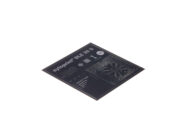
nyloprint® WA 116 SD
Water washable coating plate for security printing
Main specifications
- Base Materialaluminium
- Color of raw platered
- Total thickness (mm) (inch)1.16 (0.046")
- Plate hardness (Shore D)38
- Relief depth (mm)(inch)0.85 (0.033")
Main specifications
- Base Materialaluminium
- Color of raw platered
- Total thickness (mm) (inch)1.16 (0.046")
- Plate hardness (Shore D)38
- Relief depth (mm)(inch)0.85 (0.033")
nyloprint® WA 116 SD Overview
Benefits
PLATE CHARACTERISTICS
- Water-washable – ideal for in-house plate processing, e.g., on nyloprint® Flowline Washer
- Designed for high-quality demands in coating with UV-varnish
- Inline and offline print finishing
- For solid and spot coating
HIGHEST PRINT QUALITY
- Excellent solid density due to brilliant ink transfer of the soft relief layer
- High register accuracy due to the dimensional stability of the aluminium base
- Very good durability for long print runs
- Reliably reusable for repeat orders
EFFICIENT, CONSTANT AND FAST PLATE PROCESSING
- Highly productive and cost-effective due to plate processing within 25-35 min
- Reduced downtime on the press due to fast replacement of plates
- Wide exposure latitude combined with open reverses
ADVANTAGES OF nyloprint® DIGITAL
HIGHER PRINT QUALITY
- Reproduction of finer details and less dot gain due to digital imaging
- High-dimensional stability
- No defects caused by dust and damaged films
- No data loss during transfer
- Smoother plate surface to achieve higher ink density
- Highly consistent especially when repeating plate processing
COST EFFECTIVE AND ENVIRONMENTALLY FRIENDLY
- No film costs
- No chemicals for film development
- Electronic filing of graphics, no film storage is required
- Easy and fast data exchange – worldwide
Suitable equipment
nyloprint® WA 116 S Digital plates can be processed with nyloprint® processing equipment and all similar devices and can be used with all laser systems suitable for imaging letterpress plates
Printing inks
Suitable for UV and oil-based inks and varnishes.
Washout medium
For washout only tap water is needed.
Processing information
A detailed description of the imaging, exposure and finishing steps, as well as detailed information about handling and storing, can be found in the nyloflex® User Guide.
Certification
XSYS printing plates are produced at Willstätt production site, which is certified according to international standards for quality management (DIN EN ISO 9001:2015), environmental management (DIN EN ISO14001:2015) and energy management (DIN EN ISO 50001:2018).
Get in touch
Let’s optimize your printing process!
Contact us for innovative solutions and expert support.
Specifications
The main specifications of the nyloprint® WA 116 SD
- Base Materialaluminium
- Color of raw platered
- Total thickness (mm) (inch)1.16 (0.046")
- Plate hardness (Shore D)38
- Relief depth (mm)(inch)0.85 (0.033")
- Tonal range (%)3–90
- at screen ruling of60 l/cm (150 lpi)
- Fine line width (down to μm)100
- Isolated dot diameter (down to μm)400
- Distortion factor (mm) (inch)5.4 (0.212")
- Main exposure (min)3–4
- Washout speed Flowline Washer (mm/min)160–180 (post exposure switched off)
- Drying time at 80°C / 176°F (min)10
- Post exposure (min)2
 Product Brochure EN
Product Brochure EN 